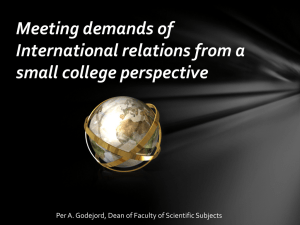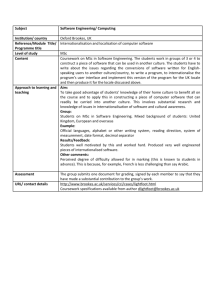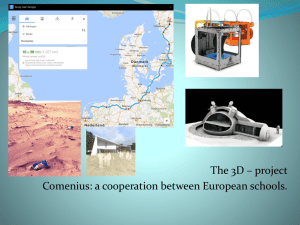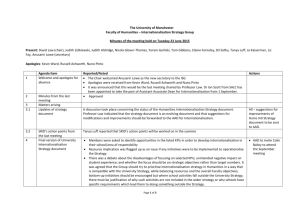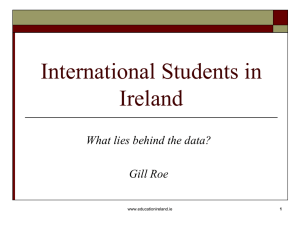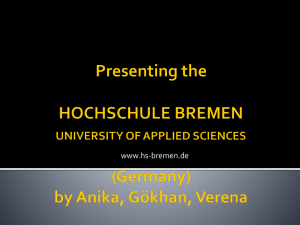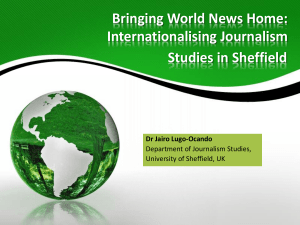Internationalisation of the Curriculum Definition
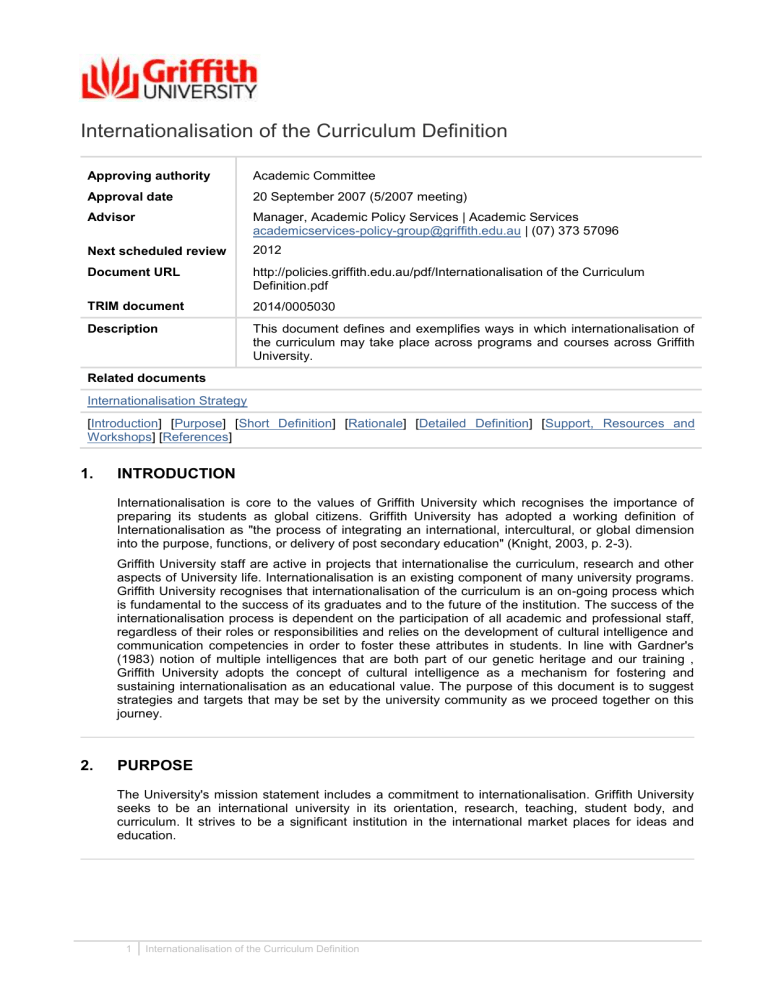
Internationalisation of the Curriculum Definition
Approving authority
Approval date
Academic Committee
20 September 2007 (5/2007 meeting)
Advisor Manager, Academic Policy Services | Academic Services academicservices-policy-group@griffith.edu.au
| (07) 373 57096
Next scheduled review 2012
Document URL
TRIM document http://policies.griffith.edu.au/pdf/Internationalisation of the Curriculum
Definition.pdf
2014/0005030
Description
Related documents
This document defines and exemplifies ways in which internationalisation of the curriculum may take place across programs and courses across Griffith
University.
Internationalisation Strategy
] [ Short Definition ] [ Rationale ] [ Detailed Definition
1. INTRODUCTION
Internationalisation is core to the values of Griffith University which recognises the importance of preparing its students as global citizens. Griffith University has adopted a working definition of
Internationalisation as "the process of integrating an international, intercultural, or global dimension into the purpose, functions, or delivery of post secondary education" (Knight, 2003, p. 2-3).
Griffith University staff are active in projects that internationalise the curriculum, research and other aspects of University life. Internationalisation is an existing component of many university programs.
Griffith University recognises that internationalisation of the curriculum is an on-going process which is fundamental to the success of its graduates and to the future of the institution. The success of the internationalisation process is dependent on the participation of all academic and professional staff, regardless of their roles or responsibilities and relies on the development of cultural intelligence and communication competencies in order to foster these attributes in students. In line with Gardner's
(1983) notion of multiple intelligences that are both part of our genetic heritage and our training ,
Griffith University adopts the concept of cultural intelligence as a mechanism for fostering and sustaining internationalisation as an educational value. The purpose of this document is to suggest strategies and targets that may be set by the university community as we proceed together on this journey.
2. PURPOSE
The University's mission statement includes a commitment to internationalisation. Griffith University seeks to be an international university in its orientation, research, teaching, student body, and curriculum. It strives to be a significant institution in the international market places for ideas and education.
1 Internationalisation of the Curriculum Definition
3. SHORT DEFINITION
For Griffith University, internationalisation is underpinned by a commitment to Cultural Intelligence across the institution.
Cultural Intelligence is the capacity of individuals to adapt to different people from diverse cultures and the ability to manage this interconnectedness harmoniously and productively (Earley, Ang, &
Tan, 2006).
It is a reciprocal process whereby students and staff from diverse social and cultural backgrounds exchange expertise, knowledge, and experiences to enhance their understandings and capacity to effectively live and work in changing local and international communities.
Internationalisation of the curriculum content and processes, including assessment, is one mechanism by which Cultural Intelligence is promoted among students and staff at Griffith University.
4. RATIONALE
The rationale for the internationalisation of undergraduate and postgraduate education is grounded in our belief that the acquisition of global awareness and an understanding of the diversity of cultures and societies on our planet is an integral part of education. It is essential to the development of global citizenship and our aim to equip our graduates for work in an international, multi-cultural, and multi-lingual environment.
Demand for graduates who are internationally-knowledgeable and interculturally-competent
(Knight, 1997, p. 30)
Increased international mobility of students and staff (both Australian and International)
Increased global interdependency in terms of political, environmental, and social problems and issues
Rapid development of new information technologies
Globalised economies, markets, and international alliances
Respect for social and international diversity is a Griffith University Graduate Attribute
5. DETAILED DEFINITION
The detailed definition includes the points 5.1 to 5.4 below.
5.1 An internationalised curriculum includes practices that:
Provide an inclusive learning environment within the Australian tertiary education context
Value diversity and internationalisation as integral to all programs
Ensure that international perspectives inform curriculum design
Construct learning and teaching activities in ways that are culturally sensitive
Use international examples integral to learning activities
Use educative multi-cultural cohorts to facilitate formal and informal learning by encouraging heterogeneous rather than homogeneous groups to work together
Improve through development, review, and self-evaluation
Enhance personal and academic communication amongst the university's culturally diverse communities
5.2 Strategies to internationalise the curriculum for local and international students
Include international content in the curriculum wherever it is educationally possible and desirable to do so (e.g. inclusion of national and international case studies)
2 Internationalisation of the Curriculum Definition
Broaden the traditional/original subject areas through international and/or intercultural approaches to teaching and learning
Actively discourage language or behaviour that is ethnocentric or racist, and avoid use of cultural stereotypes
Include materials from international and intergovernmental organisations (including international research) to broaden the learning experience and knowledge base of students and academic staff
5.3 An internationalised curriculum in which traditional/original subject area is broadened by international and/or intercultural approaches includes:
Avoidance of monolithic descriptions of other nations and/or cultures
Specific references to contemporary international and Australian content
Ethical issues in globalisation such as social justice, equity, human rights and related social, economic and environmental issues
International case studies for comparison to national case studies
Historical accounts of the development of current international discourses/practices
Studies of professional practices in other nations/cultures
Comparative studies of how knowledge is constructed differently across cultures in the subject area concerned
Utilises student/staff diversity in the classroom/course/program to facilitate discussion and exchange of ideas
Introduces changes in dialogue to reflect cultural preferences and to nurture collaborative learning practices for deep learning and cross-cultural critique
5.4 An internationalised curriculum demonstrates communication that includes coursework and classroom practices that encourages:
Mutual respects so that staff members
- make a point of acknowledging the cultural heritage and home languages of their international students
- make a point of knowing how to pronounce the names of their international students
- understand the importance and significance of sacred days or religious holidays of their students, (e.g., fasting days )
Students to gain a deeper knowledge and understanding of at least one other culture in terms of its customs, history, language, literature, philosophy, economics, and politics.
Students and staff to learn a second language as a basis for appreciating the challenges of self-expression in language other than one's mother-tongue
6. SUPPORT, RESOURCES, AND WORKSHOPS MAY BE NEEDED TO SUPPORT
TEACHING AND SUPPORT MONITORING
6.1 Support for teaching
Assist with shared terms and definitions that help to define existing practice that contains international qualities
Provide staff training in intercultural communication strategies
Support academic staff in developing an internationalised approach to teaching
Support academic staff in developing strategies to teach and assess students from non-
English speaking backgrounds
Encourage academic staff to provide feedback on issues of language skills (writing, spelling, and grammar) in constructive, helpful ways
3 Internationalisation of the Curriculum Definition
Encourage academic staff to know of the services provided by the university that are most useful to students from non-English speaking backgrounds
6.2 Support for monitoring
Assist with documentation, reporting, and dissemination of exemplary practices and strategies that demonstrate effective internationalisation of the curriculum
Create a graded scale to assist academic staff to chart the degree to which they perceive a course as internationalised (e.g., low level, medium level, high level)
Assist with identification and initiation of appropriate internationalising processes
Assist with assessment of the currency of the international content in the programs
Monitor the degree to which the learning and teaching strategies and activities are appropriate - including students' perceptions
Ensure that academic and professional staff are cognisant of the relevant legislation pertaining to internationalisation in Australia (e.g. the Educational Services for Overseas
Students (ESOS) Act 2000 (as amended in 2007) and the National Code)
Compare (benchmark) activities to national best practice
Provide opportunities for staff to showcase the indicators they are achieving in their curriculum
Provide a Checklist/Toolkit for assessing internationalisation of the curriculum (To be developed and hosted on the Learning Futures website)
7. REFERENCES
Earley, P. C., Ang, S., & Tan, J.-S. (2006). Developing cultural intelligence at work. Stanford, CA:
Stanford University Press.
Gardner, H. (1983). Frames of mind: The theory of multiple intelligences. New York: Basic Books.
Knight, J. (1997). A shared vision? Stakeholders' perspectives on the internationalization of higher education in Canada. Journal of Studies in International Education, 1(1), 27-44.
Knight, J. (2003). Updated internatinalization definition. International Higher Education, 33, 2-3.
4 Internationalisation of the Curriculum Definition
